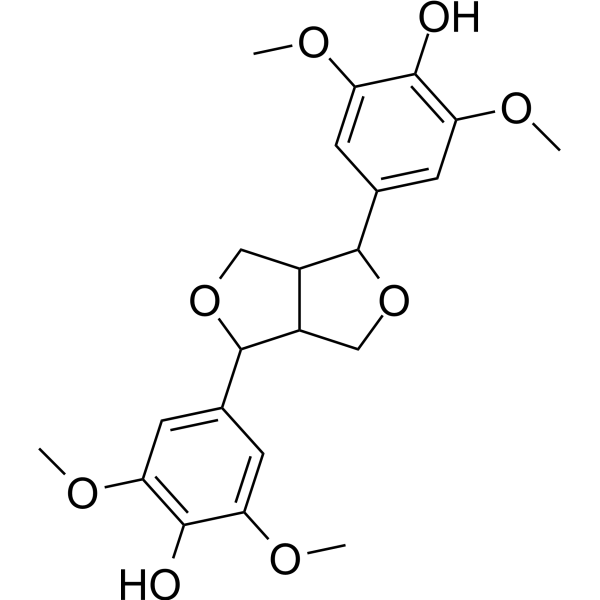
Syringaresinol
CAS No. 487-35-4
Syringaresinol( —— )
Catalog No. M31195 CAS No. 487-35-4
Syringaresinol is a lignan extracted from the sap of Lobelia longifolia with anti-inflammatory activity. syringaresinol causes vasodilation and enhances NO production through phosphorylation and dimerization of endothelial NO synthase.
Purity : >98% (HPLC)
 COA
COA
 Datasheet
Datasheet
 HNMR
HNMR
 HPLC
HPLC
 MSDS
MSDS
 Handing Instructions
Handing Instructions
| Size | Price / USD | Stock | Quantity |
| 5MG | 288 | In Stock |


|
| 50MG | Get Quote | In Stock |


|
| 100MG | Get Quote | In Stock |


|
Biological Information
-
Product NameSyringaresinol
-
NoteResearch use only, not for human use.
-
Brief DescriptionSyringaresinol is a lignan extracted from the sap of Lobelia longifolia with anti-inflammatory activity. syringaresinol causes vasodilation and enhances NO production through phosphorylation and dimerization of endothelial NO synthase.
-
DescriptionSyringaresinol is a lignan extracted from the sap of Lobelia longifolia with anti-inflammatory activity. syringaresinol causes vasodilation and enhances NO production through phosphorylation and dimerization of endothelial NO synthase. Syringaresinol is a potential compound for the treatment of cancer and ischaemia-related diseases, inducing cardiomyocyte damage and death by activating FOXO3 to degrade HIF-1α±.
-
In Vitro——
-
In Vivo——
-
Synonyms——
-
PathwayOthers
-
TargetOther Targets
-
Recptor——
-
Research Area——
-
Indication——
Chemical Information
-
CAS Number487-35-4
-
Formula Weight418.4
-
Molecular FormulaC22H26O8
-
Purity>98% (HPLC)
-
Solubility——
-
SMILES——
-
Chemical Name——
Shipping & Storage Information
-
Storage(-20℃)
-
ShippingWith Ice Pack
-
Stability≥ 2 years
Reference
molnova catalog



related products
-
Cyclo(Ser-Pro)
From Pantoea agglomerans.
-
Resorcin monoacetate
Resorcinol monoacetate is an antiseptic and a disinfectant, is a chemical intermediate for the production of many other pharmaceuticals, and can be used to treat acne, seborrheic dermatitis, eczema, psoriasis, and other skin disorders.
-
Ganoderic acid M
Ganoderic acid Me and/or ganoderic acid T have obvious action for inhibiting human tumor cell growth or proliferation, at the same time its toxicity for normal cells is low.



 Cart
Cart
 sales@molnova.com
sales@molnova.com


